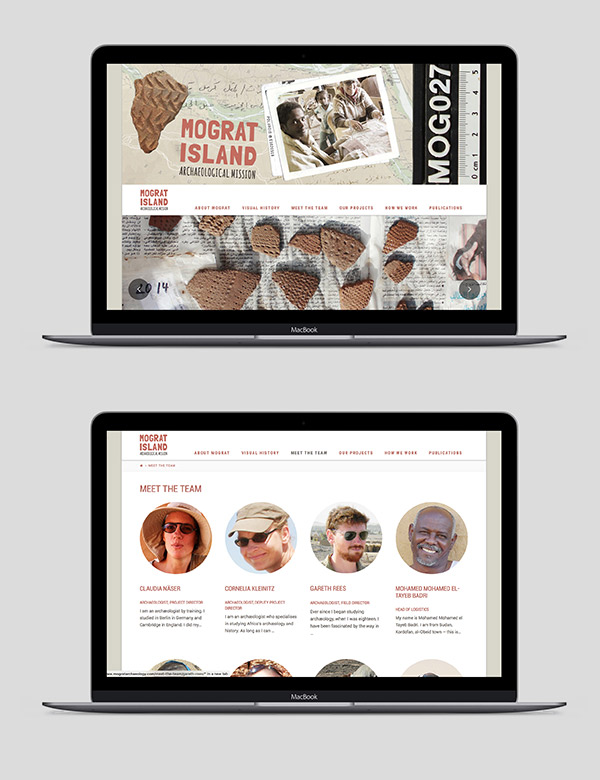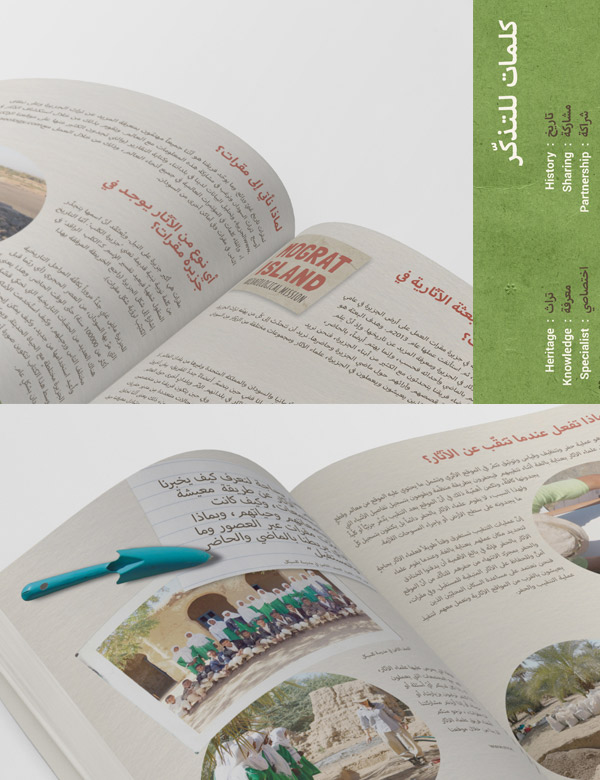Mograt Island Archaeological Mission
Humboldt University Berlin, Department of Sudanese Archaeology
2014-2016
Mograt Island is the largest island in the Nile, parked at a bend in the river in northern Sudan. Since 2013, The Mograt Island Archaeological Mission, a team of international researchers from Cambridge, Humboldt and other universities has been studuing the archaeology of the island. But archaeology is not only about the past. Applying a post-colonial approach to research practices, the team has gotten to know the local residents, their stories and their views of the island’s past and present.
The Objective
In order to enter into a dialogue with everyone interested in the island’s heritage, including archaeologists, local residents and the diverse range of visitors to the island from Sudan and abroad, I was brought in to work closely with the core team of archaeologists, developing an overarching visual identity and several communication tools for both the local and scientific communities. The intention was not only bridge the gap between the first world and the third world, but also build a bridge between the scientific community and an audience of interested public.
The key factors to be considered included attending to the specificity of of local technology, cultural practices & community engagement on Mograt island while also speaking effectively and professionally to an international scientific community.
The results should include a logo, website, book, map and academic presentation templates. Oh yeah, and everything in both English and Arabic too.
The Process
I led the team on a deep dive workshop unpacking different conceptual aspects of the project, from the overarching mission and values, to look and feel, target groups and other relevant factors. As the conversation went on, key themes emerged that became touchstones throughout the concept, design and prodction process. Themes of:
Inclusion – feeling invited, accessible
Engagement – open and available for conversation
Parity – not being white, male, privileged authority – speaking human to human, not scientist to layman
Archaeology – is fun and interesting and relevant, not just for scientists.
How could these themed elements be woven into and expressed in the concept and design? Some examples include:
Look & Feel – Initial sketches for logos and web screens emerged, showing different kinds of collaged and hand made / hand written qualities. Layers of photos, isolated objects and information systems mirror themes from the visual brainstorm results while also reflecting playful design aesthetics appropriate for schoolchildren and scientists alike. Colors were inspired by the local Mograt hues of reddish earth and deep green foliage.
Design – A vertical timeline, used on the website and in the book, showing the history of the Sudan and Mograt side-by-side as if digging down from modern time deep into the past.
Language – Books written in English and Arabic, with careful attention to differences in spelling and word choice for the Arabic translations to reflect the unique qualities of Sudanese Arabic. Countless rounds of Arabic typesetting edits to reflect the changes to the English text and its translations.
Haptics – The books were printed in Europe, to look and feel equivalent to what a school or museum would produce for its students here. Most of what is published within the archaeological and Sudanese community is poorly printed on low quality paper. Instead we printed on premium recycled paper with coated cover and finished, glued spine. Each detail intentionally signalling parity and inclusion while making archaeology fun and accessible.
Surprising Results
In a recent meeting with one of the project leaders , I asked how the project was going, and the response to the materials we produced. Claudia leaned in to me across the table and said: “You know, all the books are gone. Everyone wants one, they went so fast. I asked a local contact what they might be worth, if we wanted to reprint them and sell the book in tourist locations. He told me that the book is priceless. I asked for clarification, because maybe the Arabic word meant something else. But he confirmed, it was beyond a monetary value, priceless because of the way it felt – not just good the paper, but all the meaning built into it. They can feel it.”







Sorry, the comment form is closed at this time.